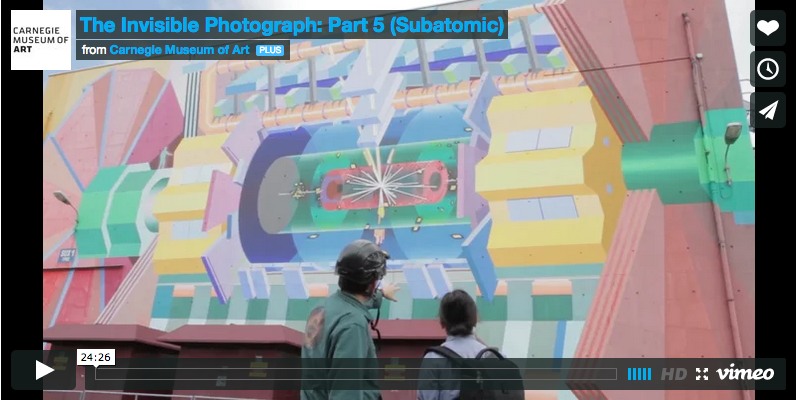Filmmaker Arthur Ou and his team visited CERN to investigate how photographic technologies are being used to visualize the subatomic world. The resulting documentary, Subatomic (shown above) is the fifth episode in the series The Invisible Photograph(link is external), made in collaboration with Arts @ CERN for the Carnegie Museum of Art(link is external) in Pennsylvania, US. The film draws parallels between concepts and technologies in particle detection and photography.
The Invisible Photograph: Part 5 (Subatomic) from Carnegie Museum of Art on Vimeo.
Guided by mechanical engineer and filmmaker Neal Hartman of Berkeley Lab, US, Ou uses antique photographic equipment to capture black and white images of the ATLAS detector. Hartman works on the ATLAS pixel detector – apparatus 1.5 metres long that takes 40 million pictures per second of particles created in collisions at the heart of ATLAS. “The detector is like a digital camera […] trying to take a picture of the birth of the universe,” says Hartman. “A different technology, but more or less the same concept.”
Antimatter physicist Michael Doser also uses photographic techniques in AEgIS – an experiment that looks for differences between matter and antimatter. “We use photographic emulsion to measure the tiny vertical shift as antihydrogen atoms fall as they travel across one metre,” says Doser. Antiprotons entering an emulsion annihilate with nuclei in the emulsion and produce a burst clearly visible on a photographic plate. Fragments of nuclei fly in all directions, producing tracks on the plate. The AEgIS researchers then scan the emulsion with a microscope, layer by layer, to reconstruct the tracks in a 3-dimensional computer image.
Filmmaker and former Collide @ CERN artist-in-residence Jan Peters also makes an appearance in the film, providing pictures of the ATLAS pixel detector. Hartman was paired with this artist as an “inspiration partner” – a fruitful collaboration that led to a video project documenting upgrade and maintenance work on this detector. The whole ATLAS experiment underwent maintenance and upgrades during CERN’s long shutdown, in preparation for running the Large Hadron Collider (LHC) at the higher energy of 13 TeV.
“I think it’s really important to bring the arts to a laboratory like CERN because it […] creates new ways of looking at the world,” says Arts @ CERN founder Ariane Koek. The overlap between particle detection and photography is a case in point. “Often, old technologies can be used to create new knowledge,” says Koek.
Subatomic will be shown as part of the Invisible Photograph series at CineGlobe(link is external), the International Film Festival at CERN, which will run from 24 to 29 March 2015 at the Globe of Science and Innovation on the laboratory’s Meyrin site in Switzerland. For this its fifth edition, on the theme of “Convergence” of science and image, the festival will present more than 60 short films, inspired by science, from all over the world. Find out more(link is external)about the films and the special events at CineGlobe.

